Perfect Swinging-Sphere
Upside right at this picture again a ´spiral-spindle´ is drawn, now in vertical direction between ´north- and south-pole´. Its room for movements is marked light-green. Balancing movements here are demanded in vertical direction, like marked by dotted arrows E and F. This is practically identical to previous discussed horizontal double-crank at its equatorial plane. So both double-cranks are mutually conditional.
Below at this picture are drawn two cross-sectional views and each one connecting-line is drawn thick. At left side an aetherpoint G momentary is far down. Right side shows the situation one half phase later, where the same aetherpoint (now marked H) is positioned far upside. All around are drawn additional spiral connecting-lines, which all are swinging analogue. At this animation the motion process is visualized. All points at the connecting lines keep constant distances. At this cross-sectional view, all points are moving some clock-wise and afterward back again. Instead of the flat plane of this picture, in reality all movements naturally are swinging at round tracks.
Here are drawn only vertical and horizontal cross-sections, which in principle are identical. Each other cross-section results the same picture. The whole system is symmetric around the centre. The whole sphere is internal synchronous and uniform swinging. Starting from the ambient ´stationary´ aether, the swinging movements are running on increasing radius. After a maximum the radius becomes shorter again, so this motion-pattern shows merely movements at the centre. This is the motion-principle of the electron, which is extreme stable-in-itself.
Even all clocks are turning by likely speed, different distances come up between the ends of the hands. When two hands are positioned horizontal and show into opposite direction, long distance C is given. When two hands show towards each other, a short distance D is given. At the row below, all hands are connected by a curved line. Within one half of time, the connecting-line is long stretched (E, black), at the second half of time (F, blue) it´s shorter. So the distances between aetherpoints would no longer keep constant - what is not admitted within gapless aether.
At the row below a simplistic solution for that problem is drawn. Within gapless aether all movements must occur conform. Here the principle is a likely swinging of all aether around the equator. These clocks can not show same ´time´ everywhere, otherwise all aether would swap upside (and pile up at one pole and flatten the other pole) and at the following all aether would flow down. In order to balance these movements, the clocks must turn ´time-shifted´. So the aether can swap some up-and-down all around. It is not necessary to arrange the clocks symmetric (as assumed upside). The clocks well can be positioned near together (like at G) or some far off each other (like at H). Then the aetherpoints of the black connecting line are constant. They keep constant while the swinging, when the fulcrums are not totally stationary. At the other hand this problem is not grave, because these twelve clocks must not be time-shifted exactly one hour.
Unequal
An electron is a very small motion-unit, a photon is even much smaller, so the dimensions of these swinging movements must be smaller again. Previous ´clocks´ are overdrawn at least be thousands. Also strong overdrawn are the curves of these connecting lines. If the radius of that motion-unit would be one meter, the line could differ from a straight line by only one millimeter (as I suggest). So previous ´problems´ are most oversized. In addition the balancing movements within that sphere occur into all three dimensions all times. Within that unit do not swing these few lines and not only in pure shape of that double-crank. Realiter exist numberless swinging motions at spiral winded curves within that tiny electron - permanent moving, however never totally equal.
Waves
At the second row, all hands did turn by 45 degree counter-clockwise and again at the following rows. All aetherpoints thus describe a half circle (and will come back to their starting points after following four time-sections). That´s the real movement of the aether at relative narrow space. Besides this however an additional seeming motion of the curve appears: the wave-hill wanders from left to right and also the wave-valley.
Swinging-Variations
This picture at C shows, both radius R1 and R2 can have different length. Above this, the turning-speeds can vary and also the turning-sense can be likely or contrary. Depending on constellation, an observed aetherpoint will move at most different tracks. At D for example is sketched a frequent appearance in shape of two loops. The aetherpoint is moving at an outward bound spiral track and afterwards comes back at a narrow spiral track. This motion equals loops of varying size, where again there are phases of acceleration and deceleration.
An important variation is sketched at this picture at E. There is a relative wide swinging with radius R2 (face marked red). The fulcrum is not stationary, but wanders around at relative short radius R1 (marked blue) around the centre. Resulting is a ´rosette-pattern´, like shown at F. Depending on ratio of length, turning-speed and turning-sense, the observed aetherpoint moves at long and sharp or broad and flat loops, more or less far and fast around the centre, by loops wandering forward or retrograde. So infinitive possibilities exist for motions into all directions. There is only one limitation: neighbours must behave adequate. However this does not demand everywhere only pure identical movements within the gapless aether. Smooth transitions are possible all times, e.g. simply by varying length of radius.
Indeed, the rough wallpaper-design of previous ´clock-pattern´ at picture 09.03.03 can not be decorated all around a ball. Finally with the complex motion-pattern of picture 09.03.06 such spheres are possible. Just the variations and smooth transitions allow the complete balancing within a motion-unit. The sphere is the most perfect body. All circles automatic are closed within themselves. Thus also local changes in principle and necessarily will finally be balanced.
Internally the movements are limited by the ´pliability´ of the aether-substance. The ´bend-ratio´ probably is less than 1:1000, i.e. the aether also within a local unit is nearby stationary with only minimal motions. Towards outside must exist gradual adaptation to ambient Free Aether. However there are no fix borders and the ´surface´ of such motion-spheres is permanent ´vibrating´. The stability of such motion-units comes up only by the general external aether-pressure. Finally that´s why motion-units appear ´hard´ or even to be ´particles´ which can interact with ´materia or physical fields´.
Electric Balls
Today merely exist fireplaces with an open sooty chimney. So these appearances are rather seldom and even more rarely photos were made (e.g. at an underground car park, see picture below). At special labs occasionally such ´energy-bundles´ are generated. Also there one could not detect the internal structures exactly. At any case these must be electric fields, closed inside themselves. The air-particles inside are ionized or transferred into a plasma-state. The material particles however are shining only as a secondary effect. The huge energies by themselves can only exist as fields, fields can finally exist only in shape of movements, which can not exist within nothing. Thus also these ball-lightning must exist by the aether, which is swinging most intensive within that local unit.
A Face and a Pipe
Towards upside and below these motions must be reduced to the narrow nervous trembling of the resting Free Aether. That´s why balancing-areas are demanded, here marked as light-red layers. The reduction of motion-intensity is done in shape of double-cone (resp. simple-cranks) and representative for all aetherpoints here only three double-cones are marked light-green at the faces. Within these balancing layers again all neighbours aside are swinging completely synchronous, so also here all distances between aetherpoints keep constant.
Thus between resting aether-layers well can exist faces of aether with wide swinging movements. One could rebuild that motion-model just pure mechanical. Between two surfaces (blue) many parallel rods are installed, which all are bended likely. At the middle (dark-red layer) they could be connected for keeping constant distances (and also at horizontal layers of balancing areas as you like it). At the ends the rods are beard turnable. If the rods are little bit elastic, they also could be fix installed within the stationary layers. At any case now the middle layer can do swinging movements (at round tracks as you like it). The rods represent the function of connecting-lines - and corresponding to that mechanical model, also within gapless aether can exist internal movement - within the frame of its possible curvature (which here is extremely overdrawn).
No matter how large these planes are, they allow parallel swinging between planes defined stationary. At this simple motion-model some problems come up only at the borders. At the planet Jupiter these problems e.g. result most violent moving surface with storms and turbulences (especially because Jupiter shows also retrograde swinging layers, see chapter 08.20 ´Aether-Vortices of Gas-Planets´). Here for example this problem will come up again by conception of sheet-capacitors.
Two swinging Layers
This offers a solution for previous ´border-problem´. During the contrary swinging of both layers, momentary e.g. a face reaches ´over the border´ while same time the other layer is ending some back. So at the borders must occur an exchange in vertical direction. This will not occur linear but by tracks of round bows. Left and right side at D and E, such bows schematic are sketched - and each corresponds to one half of previous pipe. So one can easy imagine as limitation for the swinging faces, all around the borders exists a ´half-pipe´ (previous pipe divided in longitudinal direction).
Opposite one can imagine, the pipe at B is cut in halves and between both round halves that block C is inserted with its plane layers. Like all swinging is closed in itself within the pipe, all motions within the flat motion-pattern inclusive rounded borders will run endless without problems (again also at simple circled tracks or by swinging-with-stroke or at loops or rosette-pattern etc.).
At this block below, the layer F is marked dark-grey. That ´stationary´ face could exist e.g. by copper and thus would build an electric conductor. The swinging of aether-layers upside of that solid layer one well can call ´electric charge´. This motion-pattern is pressed against the surface of the conductor by the general aether-pressure. The narrow and nervous trembling of the Free Aether wants to enter that ordered motion-structure. If however that pattern internal is well ordered, it resists the pressure respective opposite, the charge is conserved at that surface by the ambient Free Aether. The charge layer is pushed everywhere to likely height at the conductor.
Electron blast-off
Through these charge-layers can run disturbances or vibrations, which naturally produce increased movements especially at such corners. Thus that ´quarter-sphere´ could get blast-off the edge. As all aether is forced to move synchronous at its best, neighbouring aether is forced to accomplish that part to a complete sphere. If this is not achieved, that motion-fragment is ´shreddered´ by the Free Aether. If the supplementation occurs sufficient - a new free electron is born. Thus electric charge and electron will really show similar motion-pattern, the charge by a flat ordered swinging, the electron by sphere-shaped structure. An electron thus indeed is a ´drop of electric charge´.
Aether-Model of Atoms
By my view of the aether, the atoms are compounds of diverse vortex-spindles, arranged radial to the centre and building a sphere-shaped motion-unit. At 09.03.09 upside left at A for example is sketched a cross-sectional view, showing eight spindles (respective double-cones respective simple cranks). The best arrangement is achieved by pairs, because they can build double-cranks at a diameter of the sphere. At one side the swinging appears left-turning, like marked by arrow L. By view from outside at the opposite side, that swinging appears right-turning, like marked by arrow R.
In order to differ the real electrons from these vortex-spindles, I call them ´eyes´. An atom has as much eyes as commonly electrons are assumed. At this picture upside left, the sphere-shell of most intensive swinging motion is marked by a yellow ring. Upside right at B this area schematic is sketched as yellow surface of a hollow-sphere. When the eyes are spread equal at the surface, at least two ´islands´ come up, one with left- and one with right-turning vortices. The example shows the six-valency carbon-atom with each three left-turning red and three right-turning blue eyes. There come up two horseshoe-shaped ´ridges´, each with likely sense of swinging. Between these hills are areas of balancing and thus less motions. Into such ´sunks´ for example four grey hydrogen-atoms can ´nest´, thus building molecule CH4 as a whole.
At this picture below right side at C, an eight-valency oxygen-atom is sketched, however in shape of an isotope with five left- and three right-turning eyes. The sunks between the hills build docking-stations e.g. for two grey hydrogen-atoms, resulting the molecule H2O. As mentioned, that´s just my answer for the insufficient explanations of common theories. I explained these consideration comprehensive at chapter 08.13. ´Aether-Model of Atoms´. With concern to electric-technics only the surrounding shell of the atoms is important.
Membranes
If such motion-complexes as a whole are well structured, also the environment will get into ordered swinging. If the atoms are arranged in regular grids, also the Free Aether between is moving accordingly (areas marked light-grey) and at the outside face a joint shell comes up. In optimum case the surface of that ´aether-membrane´ (dark grey) is so even, flat charge can stick on especially good respective ´current´ can flow along such conductors (like shown in details at later chapter).
Elasticity
At B two atoms are moving towards each other, like e.g. by steady collisions between gas-particles. The vortex-spindles (of previous picture at A) become compressed into longitudinal direction like ´springs´ and accordingly must extend aside. The increased tension affects stronger mutual pressure, so the atoms fly off again.
That process occurs inevitably only within a gapless medium. Only here each impulse is completely returned. Only by that background fact, e.g. a gas keeps constant temperature, in spite of numberless collisions between the huge number of particles. If the atoms would swim within ´Nothing´, strong collisions would result similar deformations. However a part of the deformation-impulse inevitably would run off into the surrounding nothing, thus would get lost without any effect. As the universe up to now does not show energy-loss, the aether inevitably must be gapless and can not exist by particles. Only based on this aether-property, elastic pushes can occur without losses.
Stressed Aether
Naturally the general aether-pressure works against this extension. If however the aether between the atoms is tensioned up to the limit of its curvature-possibilities, the necessity of diversion is much stronger than the normal swinging of Free Aether. Nevertheless, the general aether-pressure will strongly affect onto the side-flanks with their wide surfaces (see blue arrows right side). A part of the bulge can be cut-off and thus a part of the stress-causing winding is redirected towards outside. If e.g. a tungsten-wire is heated strongly, its atoms are trembling extreme fast within their grid - and push off such photons.
Photon
At previous picture below right side at F, the motion-pattern of a photon is shown and visualized by the animation. All neighbouring aetherpoints (in the direction of the flight) are swinging only once around at circled track, however each some time-shifted. The frontside aetherpoint is just starting the movement, the aetherpoint some behind did move already some longer way at its track, the aetherpoint most back did return already to its original position and keeps resting there.
So when a photon is running forward, no particle is racing through the space. All aether in general keeps stationary. Only the motion-pattern is forwarded through the aether. That pattern is most simplistic: swinging only one turn around, at the frontside the circling starts, increases to the middle, afterward reduces back to ´standstill´, finally at rear end of the pattern.
Thin flat Disc
At D once more is sketched, no aether and no ´photon-particle´ is running through the space. Instead of, all neighbouring aetherpoints start swinging off their place at a round track and come back again to their old spot. The impression of a ´wave´ running forward comes up only by the fact, the circling movements of involved aetherpoints occurs time-shifted.
The motion-pattern thus again is a double-cone respective a simple crank. Their space of movement is marked light-red at E. At every moment the connecting-line of neighbouring aetherpoints builds a spiral curve. That motion is started by ´hard collision´ of atoms. The gapless aether allows the progression of the impulse without loss, quite real (like otherwise only assumed pure fictive by theoretic model of ´ideal gas´). The permanent ´thrust´ comes up by general aether-pressure, which at second half of time pushes each aetherpoint back to its original place (see arrow left side). This push is moving aetherpoints inside of that motion-unit spiral-diagonal towards frontside and outward. So by likely force aetherpoints at the frontside of the photon are pressed off their original location (see arrow right side).
This increasing and reducing of motion-radius, in principle is identical to cranks and double-cranks of motions inside of electrons and atoms. New is only the fact, that structure same time is wandering forward within the aether. Into longitudinal axis the radius can temporary get longer and shorter again at that ´cone-mantle´ without problems. The photon thus can show relative short ´wave-length´. However, the width of a photon commonly is far beyond common assumptions. The ´amplitude´ of suggested ´wave´ is much wider than expected.
At this picture right side at F, a black spiral connecting-line is drawn and the area of its swinging is marked dark-red. The sideward-movements force all neighbouring aetherpoints to analogue swinging and all distances between must keep constant all times. Such simple-cranks have only one swinging plane and theoretic they are reaching infinite wide (see previous ´border-problem´ at picture 09.03.08 at A). The situation is only moderated because the simple-crank is winded and thus shows some balancing effect within itself. Here that gradual reduction is marked by smaller spiral curves upside and below the core-area. However I suggest, a photon will be hundred to thousand times wider than long (as usual, these drawings can not be true to scale, otherwise the principle would not be visible. Realiter the light-red area should be drawn much wider).
By view of that aether, thus the ´electromagnetic waves of visible spectrum of frequencies´ appear other kind: as a concrete motion-pattern in shape of a spiral winded swinging disc, which is relative thin however extreme broad, and only the structure of the movements is forwarded through the aether, which in principle keeps stationary all times. Naturally this understanding has far-reaching consequences, e.g. for simple explanation of refraction of light. The results of unfortunate ´double-slot-experiments´ are easy to explain and one could leave the ill-fated idea, that innocent swinging-bundle would finally decide its behaviour by observing the observer - and insane conclusions of that kind.
Motion-Structures
No, these strange ideas are not prerequisite for understanding the new Aether-Electric-Technics. However, here is the declared aim to replace the common abstract terms of charge, current, fields, repulsion / attraction etc. by totally real motion pattern of aether within the aether. The partly strange effects (e.g. left-hand-rule) are ´nature-laws´ - and their inevitable results are only to explain by a gapless aether with its inevitable inner compulsion and restrictions. So the reader at least should accept the decisive properties of that aether as an realistic alternative to common doctrines (with their obvious phenomena and unsolved problems). Only by that understanding of the real existence of that aether, the following discussions might result advanced knowledge (otherwise the reader should stop reading here).
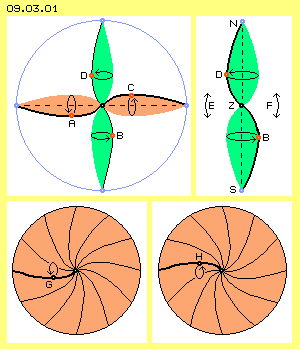 At previous chapter at picture 09.02.04 at C was shown a ´double-crank´. It´s general motion-structure is sketched once more here at picture 09.03.01 upside left. The blue ring represents the ambient aether, which stabilizes that structure by the general aether-pressure. There is drawn a spiral connecting-line in horizontal plane and the area of that swinging double-crank is marked light-red. The aetherpoint A momentary is positioned below-left and the opposite point C upside-right. In order to keep distances between all aetherpoints constant, below an aetherpoint B momentary had to swing towards right side and opposite the upper point D must momentary be some left. These movements won´t run linear up-down respective left-right, but all processes again are swinging at round tracks.
At previous chapter at picture 09.02.04 at C was shown a ´double-crank´. It´s general motion-structure is sketched once more here at picture 09.03.01 upside left. The blue ring represents the ambient aether, which stabilizes that structure by the general aether-pressure. There is drawn a spiral connecting-line in horizontal plane and the area of that swinging double-crank is marked light-red. The aetherpoint A momentary is positioned below-left and the opposite point C upside-right. In order to keep distances between all aetherpoints constant, below an aetherpoint B momentary had to swing towards right side and opposite the upper point D must momentary be some left. These movements won´t run linear up-down respective left-right, but all processes again are swinging at round tracks. Clocks all around
Clocks all around
At picture 09.03.03 upside both outside parts (light-red) of a horizontal double-crank are marked. The central part now however is drawn in shape of a ball (dark-green). At its left edge an aetherpoint A momentary is at its uppermost position and at right edge the aetherpoint B correspondingly is most down. All around the equator of that sphere, the aether shows analogue movements. Here these circling movements are marked by clocks and each end of a clock-hand represents an observed aetherpoint. Here the clock-hand left side shows upward and the clock-hand right side show down. The clocks between must be ´time-shifted´ corresponding. The light-green band thus represents the area at equator, which is shown by total length at second row of the picture. At A the hand shows upward, at B the hand shows down.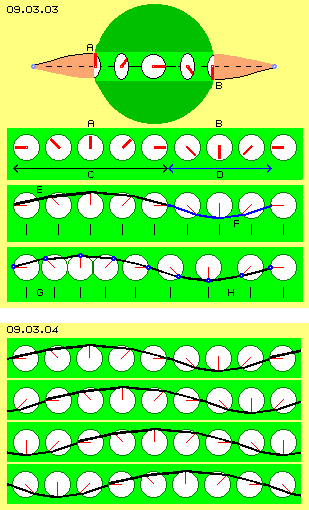 Distances of different lengths did also come up at previous discussed ´swinging-with-stroke´, which also here could bridge the divergences. At the other hand, all movements occur into all three dimensions of space at same time. These ´clocks´ must not be arranged exactly right-angle to the equatorial plane. If the clock-hands would be inclined some inward at the long distances E, the ways become shorter. If opposite at the short distances F the clock-hands would be directed some outside, the ways become longer. During the swinging all around the equator, thus constant distances between all aetherpoints are well possible (however the equator would appear little bit pulsating).
Distances of different lengths did also come up at previous discussed ´swinging-with-stroke´, which also here could bridge the divergences. At the other hand, all movements occur into all three dimensions of space at same time. These ´clocks´ must not be arranged exactly right-angle to the equatorial plane. If the clock-hands would be inclined some inward at the long distances E, the ways become shorter. If opposite at the short distances F the clock-hands would be directed some outside, the ways become longer. During the swinging all around the equator, thus constant distances between all aetherpoints are well possible (however the equator would appear little bit pulsating).
When searching for the ´perfect´ motion-pattern, one ´naturally´ assumes circle-round processes and ´naturally´ should result a geometric exact sphere. At the nature however do not exist exact straight lines, circles and spheres. And also the previous fulcrums must not necessary be symmetric arranged. The processes are strictly dictated by the properties of the aether and as it´s gap-less, constant distances between the aetherpoints are demanded. Thus unequal movements must result and sphere-shaped motion-units thus ´naturally´ must show dents and hills.
In this connection an other appearance must be mentioned, which is shown at picture 09.03.04. There are drawn nine ´time-shifted´ clocks of previous picture. The ends of clock-hands represent the observed aetherpoints. These are connected by a curved black line. At the first row, the curve builds a hill at left side and a depression at right side.![]() At this animation one can observe the turning of each clock. The tips of all hands are moving on a circled track. In addition comes up the impression, the wave as a whole would be steady shifted towards right side. This is an other example how real motions at the background are resulting additional appearances. Like at Platon´s cave one could register and believe the wave being reality, even it´s only the secondary result of the real process. We will meet that wave-pattern some later as an essential appearance of electricity.
At this animation one can observe the turning of each clock. The tips of all hands are moving on a circled track. In addition comes up the impression, the wave as a whole would be steady shifted towards right side. This is an other example how real motions at the background are resulting additional appearances. Like at Platon´s cave one could register and believe the wave being reality, even it´s only the secondary result of the real process. We will meet that wave-pattern some later as an essential appearance of electricity.
At previous clocks, the swinging was assumed at simple circled tracks. As motions within the aether are overlaying all times, pure circles practically can not exist. Upside already was discussed, how motions with stroke-component come up by overlays. This motion-process is drawn once more at picture 09.03.06 left side at A and B. Resulting is a deceleration left side at G and an acceleration right side at H. Here is drawn only one black aetherpoint and its track. Within the aether all neighbouring points must move (nearby) analogue. So whole areas of likely swinging will exist. A ´field´ of that asymmetric motion-structure affects a pulsating thrust onto local motion-units. That´s why e.g. the planets are pushed around within the sun-whirlpool. This thrust-component also is affecting at electric-technics as ´motoric force´, as discussed at later chapters.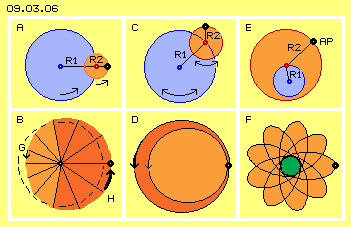 The resulting tracks can take most different shapes, e.g. ovals or 8-shaped, stretched or compressed, forward- or backward-turning. The tracks can also build loops or ´garlands´. Above this, the radius of circles must not keep constant length or constant relation of lengths. This allows smooth transition within motion-pattern respective the shape of motions can steady vary. If local motion-units (e.g. of atoms) collide, they mutually become deformed little bit and the internal swinging functions like springs. Here these processes are drawn only two-dimensional. Realiter these motion-components occur in three dimension. Thus many possibilities exist for balancing ´tensions´, e.g. to guarantee constant distances between neighbouring aetherpoints all times.
The resulting tracks can take most different shapes, e.g. ovals or 8-shaped, stretched or compressed, forward- or backward-turning. The tracks can also build loops or ´garlands´. Above this, the radius of circles must not keep constant length or constant relation of lengths. This allows smooth transition within motion-pattern respective the shape of motions can steady vary. If local motion-units (e.g. of atoms) collide, they mutually become deformed little bit and the internal swinging functions like springs. Here these processes are drawn only two-dimensional. Realiter these motion-components occur in three dimension. Thus many possibilities exist for balancing ´tensions´, e.g. to guarantee constant distances between neighbouring aetherpoints all times.
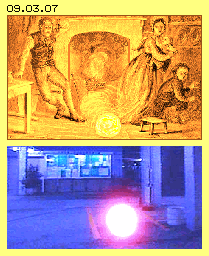 I know it´s hard for many readers to visualize such complex processes within space. Probably one never will know exactly the motions within an electron, just because they are too small and invisible. At the other hand there are examples in huge size, in shape of ´ball-lightning´. Diverse reports of these appearances exist from earlier days. Preferably these lightning balls came down the open fireplace, rolled around and disappeared also through closed windows. So for some moments these thunderstorm-born units were stabile until they dispersed (see old picture 09.03.07 upside).
I know it´s hard for many readers to visualize such complex processes within space. Probably one never will know exactly the motions within an electron, just because they are too small and invisible. At the other hand there are examples in huge size, in shape of ´ball-lightning´. Diverse reports of these appearances exist from earlier days. Preferably these lightning balls came down the open fireplace, rolled around and disappeared also through closed windows. So for some moments these thunderstorm-born units were stabile until they dispersed (see old picture 09.03.07 upside).
Nevertheless some critics negate spontaneous and categorical, motion within gapless medium could be possible at all. I would like to try once more to make that possibility plausible. At picture 09.03.08 left upside at A is drawn a section with diverse layers. The blue layers upside and below represent Free Aether (here called stationary, even their aetherpoints are ´trembling´ on narrow spaces). The dark-red layer represents aether, which is swinging at wide tracks. All aetherpoints of that layer are swinging parallel to each other. Here that swinging simplistic is sketched by circled tracks, however also could be a swinging-with-stroke or by varying loops or at rosette-tracks of previous picture. Only important is, all aetherpoints are moving parallel to each other. At this picture right side at B, now that flat motion-pattern is rolled up in shape of a pipe. All around a central stationary core (light blue) exists a balancing area (light red) with the increasing swinging movement up to a round layer of maximum motion-intensity (dark red). By an external balancing ring (light red) the movements again are reduced to size of ambient Free Aether (light blue). The double-cones of connecting lines thus here are arranged in radial direction (not drawn here). Again the swinging can run at simple circled tracks, can show a stroke-component or build loops or rosettes etc. The motion-pattern all around is closed within itself (only at the ends of the pipe previous ´border-problems´ still exist). Such pipes with huge volumes of moving aether e.g. build ´canals for flash-lightning´ (see chapter 08.20. ´Normal and Paranormal Appearances´). Analogue processes are discussed at the following concerning current at round conductors.
At this picture right side at B, now that flat motion-pattern is rolled up in shape of a pipe. All around a central stationary core (light blue) exists a balancing area (light red) with the increasing swinging movement up to a round layer of maximum motion-intensity (dark red). By an external balancing ring (light red) the movements again are reduced to size of ambient Free Aether (light blue). The double-cones of connecting lines thus here are arranged in radial direction (not drawn here). Again the swinging can run at simple circled tracks, can show a stroke-component or build loops or rosettes etc. The motion-pattern all around is closed within itself (only at the ends of the pipe previous ´border-problems´ still exist). Such pipes with huge volumes of moving aether e.g. build ´canals for flash-lightning´ (see chapter 08.20. ´Normal and Paranormal Appearances´). Analogue processes are discussed at the following concerning current at round conductors.
At this picture below at the middle at C, once more a section through diverse layers is sketched. The layer of Free Aether again is marked light-blue. The layers of balancing movements again are marked light-red. Now two layers of intensive swinging are marked dark-red. Now three double-cranks are marked light-green. Some Aetherpoints are marked black, the circled arrows show direction of swinging movements. A spiral black connecting line represents the shifted swinging of both layers: if an aetherpoint on one layer momentary is positioned in the background, the corresponding aetherpoint of the other layer is positioned in the foreground. So both layers of intensive movements are swinging phase-shifted.
So one easy can imagine, all around the swinging block D ´half-round edges´ exist, corresponding to previous pipe longwise cut in two parts. At the corner of that block, both ´half-pipes´ meet, naturally not straight but again rounded. That rounded corner practically builds one quarter of a sphere.
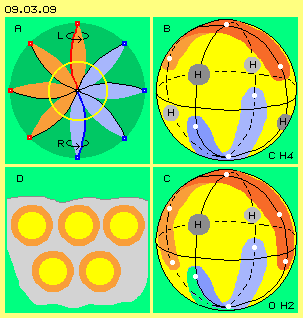 An electric conductor exists by atoms. The structure of atoms was explained by Bohr in comparison with the planet-systems. Many scientists however assume, an atom is not build by elementary-particles, no protons and no neutrons exist at all and no electrons are running around the nucleus at diverse tracks. The quantum-theories believe, elementary-particles are build by quarks. Up to now about thousand different ´particles´ are known. Strange enough they permanently change the shape and some exist only for minimum time. Everybody may believe it or not.
An electric conductor exists by atoms. The structure of atoms was explained by Bohr in comparison with the planet-systems. Many scientists however assume, an atom is not build by elementary-particles, no protons and no neutrons exist at all and no electrons are running around the nucleus at diverse tracks. The quantum-theories believe, elementary-particles are build by quarks. Up to now about thousand different ´particles´ are known. Strange enough they permanently change the shape and some exist only for minimum time. Everybody may believe it or not.
At this picture below left at D schematic are sketched some atoms. Around the yellow ´core´ of the atom a balancing area is marked light-red. Depending on suitable shape, atoms can build a stabile molecule or a compound more or less solid. The balancing areas are merging and thus a common ´aura´ encloses the whole structure. As the aether inside and around the atoms allow common swinging, also the surrounding Free Aether is moving in similar shape.
At picture 09.03.10 upside left at A two atoms schematic are sketched. The areas of intensive motions are marked yellow and the balancing areas are marked light-red. The ´aura´ is much wider than commonly assumed, like here sketched by additional light-red rings. Already from a distance, such units ´feel´ the presence of the other one. If the movements fit well, the atoms can ´lean´ against each other, e.g. also building H2- or O2-molekules. Often however the motions are contrary, at least temporary, so the atoms keep ´proper´ distance.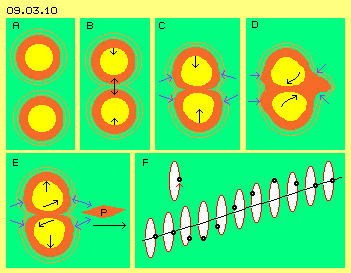 At C both atoms did crash so hard, their contours became deformed. Where the atoms meet, comes up a broad bulge, which here e.g. is marked by ´pear-shape´. The sphere-shape is optimum because certain volume is enclosed by most small surface. The ´movement-volume´ now at the bulges has enlarged surfaces, so the general aether-pressure will affect stronger (see blue arrows). Both atoms thus are pressed back into their original sphere-shape - and same time the atoms mutually are pushed off and finally flying off.
At C both atoms did crash so hard, their contours became deformed. Where the atoms meet, comes up a broad bulge, which here e.g. is marked by ´pear-shape´. The sphere-shape is optimum because certain volume is enclosed by most small surface. The ´movement-volume´ now at the bulges has enlarged surfaces, so the general aether-pressure will affect stronger (see blue arrows). Both atoms thus are pressed back into their original sphere-shape - and same time the atoms mutually are pushed off and finally flying off.
At this picture right upside at D now a situation is shown, where both atoms did crash very fast. In addition the vortices at the meeting-point momentary are swinging contrary sense, like marked by both curved arrows. Upside as an example, the connecting-lines were compared with elastic rods or finally with steel-springs. At both cases, the pliability is limited, just like within the aether. That hard collision and compression of the contrary vortices result ´stress´ within the aether. The most strong winded connecting-line forces all neighbours to analogue motions and that demands enlarged balancing areas, far beyond the original sphere-shape of the atoms. At this picture this is marked by an extreme light-red extension towards right side.
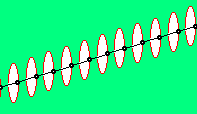 At this picture below left at E, the dark-red vortex-complex of photon P already got some off towards right side. It is further pushed off by the general aether-pressure and at the other hand, the bulges of both atoms are pressed back (see blue arrows). As the photon flies off by light-speed, the internal motions of atoms must run at least as fast. That ´liberation-stroke´ thus occurs extreme fast. Same time, the vortex-spindles of both atoms are already swinging back (see black curved arrows, each now showing into contrary directions). This swinging-back reduced previous tension. That´s why the elimination of the stress-situation demands only one turn for creating the photon. The deformation of both atoms now is reduced to ´normal´ degree (like e.g. sketched at C), so they can fly off according to normal collisions.
At this picture below left at E, the dark-red vortex-complex of photon P already got some off towards right side. It is further pushed off by the general aether-pressure and at the other hand, the bulges of both atoms are pressed back (see blue arrows). As the photon flies off by light-speed, the internal motions of atoms must run at least as fast. That ´liberation-stroke´ thus occurs extreme fast. Same time, the vortex-spindles of both atoms are already swinging back (see black curved arrows, each now showing into contrary directions). This swinging-back reduced previous tension. That´s why the elimination of the stress-situation demands only one turn for creating the photon. The deformation of both atoms now is reduced to ´normal´ degree (like e.g. sketched at C), so they can fly off according to normal collisions.
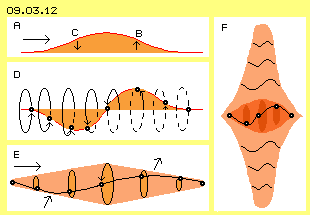 At picture 09.03.12 once more the source and cause of the motion-structure of the photon is shown. At A the starting situation is sketched. In principle the aether between the crashing atoms must ´escape´ and that deviation-movement B is running at the frontside of the photon on and on. In principle this must be compensated by a return-movement C of the aetherpoints to their original locations. This does not occur at two-dimensional plane, but that red ´hill´ is twisted, so the connecting-line is represented by a spiral winded curve.
At picture 09.03.12 once more the source and cause of the motion-structure of the photon is shown. At A the starting situation is sketched. In principle the aether between the crashing atoms must ´escape´ and that deviation-movement B is running at the frontside of the photon on and on. In principle this must be compensated by a return-movement C of the aetherpoints to their original locations. This does not occur at two-dimensional plane, but that red ´hill´ is twisted, so the connecting-line is represented by a spiral winded curve.
Within the scope of the Aether-Electric-Technics it´s not necessary to believe in these ideas about atoms, electrons and photons in all details. However it´s important to understand the progression of motion-units through the aether: only the structure of movements is forwarded, nothing else. The photon is just a one-turn-swing of aetherpoints, frontside first. Somehow more complex is the shape of an electron, in principle however it´s again an assembly of such vortex-spindles. When an electron wanders through the space, again only that pattern is transported forward. Atoms are even more complicated accumulations of vortices, however also the atoms go ahead within space not as ´material particles´ but only the complex motion-pattern change locations within the aether. It might be startling for some reader to be only a complex vortex-compound, existing not steady by certain basic material, but being an only transient pattern of motions, which flits across the universe-wide aether - however inclusive ´far-reaching spirit-vortices plus indestructible soul-pattern´.
09.04. Charge
09. Aether-Electric-Technics